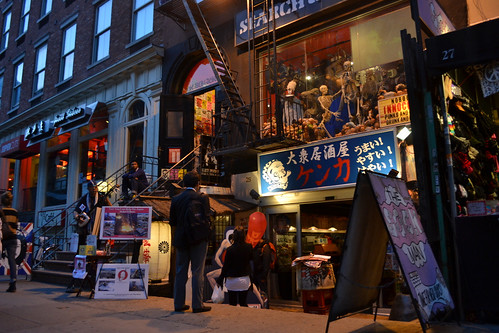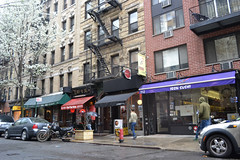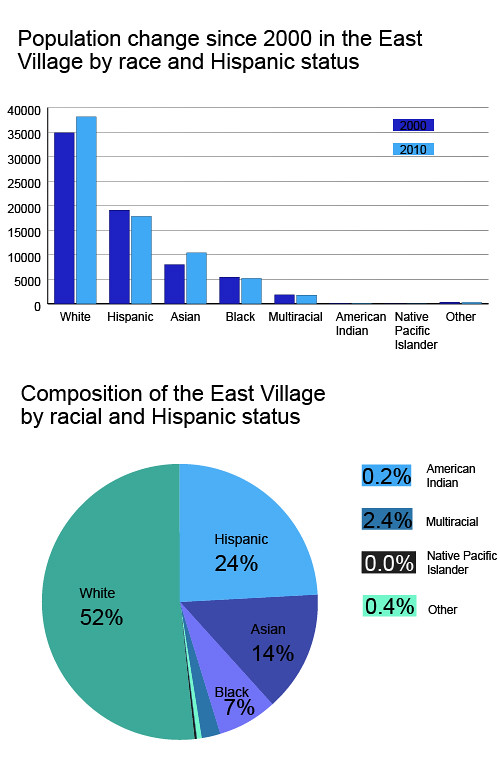 Ian Duncan A musician plays outside Kenka, a popular Japanese restaurant on St. Marks Place. Census figures show Asians to be the fastest growing ethnic group in the neighborhood.
Ian Duncan A musician plays outside Kenka, a popular Japanese restaurant on St. Marks Place. Census figures show Asians to be the fastest growing ethnic group in the neighborhood.Richard Lan’s family moved to the Lillian Wald Houses 14 years ago when he was just a baby. His mother still works in Chinatown as a janitor in a drug store, but his two older sisters led the move to the public housing in search of more space.
City statistics suggest Richard’s family is just one of many who have made the move. Data provided to The Local by the housing authority show that Asians make up almost 20 percent of East Village public housing tenants, and figures from the 2010 census show Asians to be the fastest growing ethnic group in the neighborhood. In the streets immediately north of Houston, the number of Asian residents almost doubled. Is this the beginnings of a China Village to complement Chinatown? Perhaps, but interpreting the numbers is difficult.
The housing authority data show that Asian public housing residents are relative newcomers, on average tenants for 14 years, compared to an average of 21 years for other ethnic groups. In part the influx could be a consequence of the fire that swept through Grand Street a year ago, according to Peter Kwong, a professor at Hunter College.
“There have been some complaints that several times victims of the fire in Chinatown can jump the queue for public housing,” he said.
But Mr. Kwong also sees other factors at play. The census designation Asian could refer to someone who draws his or her ethnic identity from as far west as Pakistan and as far east as Japan. Mr. Kwong suggested that Chinese people leaving Chinatown; new Japanese immigrants; and increasing numbers of international students at NYU could all be contributing to the growth recorded in the statistics.
 Ian Duncan A row of Japanese restaurants along East 10th Street. Although census figures show an uptick in the local Asian population, interpreting the data is proving difficult.
Ian Duncan A row of Japanese restaurants along East 10th Street. Although census figures show an uptick in the local Asian population, interpreting the data is proving difficult.Mr. Kwong said former residents of Chinatown are moving north in search of cheaper, more spacious apartments as landlords there are increasingly willing to rent to non-Chinese tenants in hopes of higher rents. The census figures show the number of Asian residents in Chinatown has dipped since 2000, while the number of white residents – still a minority – has almost doubled in some areas.
Others, though, dispute this interpretation. Tom Fang, president of the 2,000-member Chinese Students and Scholars Association at NYU, said East Village rents remain higher than those in Chinatown. But international students from China – the sons and daughters of the country’s increasingly wealthy middle class – can afford to pay. He knows of many members of his society who live in the neighborhood.
“Also, there is the fact that the new generation of Chinese international students are much more cosmopolitan and in tune with western culture,” Mr. Fang said in an e-mail message, “so that they do not feel the need to live in an area of high Chinese concentration.”
The Japanese community – centered around East 10th and East Ninth Streets – has received renewed attention in the wake of the earthquake and tsunami in northeastern Japan. But the census figures do not show the number of Asian residents in those streets changing significantly.
So, while a change is taking place, the picture remains incomplete. As more data is released and community groups complete their analyses, though, it should become clearer.
Census Shows An Uptick in Asian Residents in the East Village
A look at the 2010 census figures show Asians to be the fastest growing ethnic group in the neighborhood.




